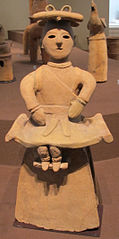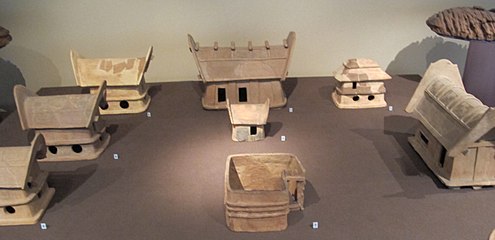Haniwa


The Haniwa (埴輪) are terracotta clay[2][3] figures that were made for ritual use and buried with the dead as funerary objects during the Kofun period (3rd to 6th centuries AD) of the history of Japan. Haniwa were created according to the wazumi technique, in which mounds of coiled clay were built up to shape the figure, layer by layer.[4]
Haniwa were made with water-based clay and dried into a coarse and absorbent material that stood the test of time. Their name means "circle of clay", referring to how they were arranged in a circle above the tomb. The protruding parts of the figures were made separately and then attached, while a few things were carved into them. They were smoothed out by a wooden paddle. Terraces were arranged to place them with a cylindrical base into the ground, where the earth would hold them in place.
During the Kofun period, a highly aristocratic society with militaristic rulers developed. The cavalry wore iron armor, carried swords and other weapons, and used advanced military methods like those of northeast Asia. Many of them are represented in haniwa figurines for funerary purposes.
The most important of the haniwa were found in southern Honshū—especially the Kinai region around Nara—and northern Kyūshū. Haniwa grave offerings were made in many forms, such as horses, chickens, birds, fans, fish, houses, weapons, shields, sunshades, pillows, and humans. Besides decorative and spiritual reasons of protecting the deceased in the afterlife, these figures served as a sort of retaining wall for the burial mound.
Because these haniwa display the contemporary clothing, hairstyle, farming tools, and architecture, these sculptures are important as a historical archive of the Kofun Period.
Everyday pottery items from that period are called Haji pottery.
History of Haniwa[]
Origin[]
Earlier, clay figurines, called dogū, appeared during the Jōmon period.
Hiroaki Sato cites a passage from the Nihon Shoki, in which Emperor Suinin issued an imperial edict concerning funerals: "From now on make it a rule to erect clay figures and not to hurt people." Thus, these clay figures may have replaced live human sacrifices.[5]
The origin of haniwa started during the latter part of the Yayoi period around the Kingdom of Kibi. During this time special earthenware figurines and bowls started to appear on top of the tombs of leaders. The early sculptures exceeded 1 m (3.3 ft) in length. They consisted of a cylindrical portion, which represented the torso, and a skirt-shaped portion at the base, which represented the legs. Many times a special insignia or pattern would be displayed on the torso. Sometimes an obi would be placed around the torso. These sculptures are thought to have been used as part of a funeral ritual. Other than the Kibi area, the only other place these sculptures were found was in the Izumo province.
During the latter part of the 3rd century AD, these sculptures started to appear on top of the imperial grave mounds in the Kinai region. During this time more elaborate haniwa appeared with earthenware bowls. It is believed that the movement of these sculptures and haniwa from the Kibi region to the Kinai region is indicative of an increase in their importance.
Later developments[]
During the earlier part of the Kofun period (later 3rd century AD) the only earthenware haniwa were cylindrical; however, toward the early 4th century AD, shield and other tool-shaped haniwa started to appear. Additionally, during the middle Kofun period (mid-5th century AD) shrine maiden, horse, dog, and other animal-shaped haniwa were introduced. As the practice of ceremonial burial mounds declined in the mid-6th century AD, haniwa became rarer in the Kinai region; however, haniwa were made in abundance in the Kantō region.
It is not uncommon for some haniwa to be painted with red dye or other colors. Besides the cylindrical haniwa (enkei-haniwa), another common type was the house-shaped haniwa (keisho-haniwa). Other things that fell into the category of keisho-haniwa were those shaped like humans, animals, and swords. The details on the haniwa give information about the elite buried in the tomb, as well as valuable knowledge of the tools or other objects people of that time used. The military haniwa inform archeologists of the armour and weapons, as well as the status symbols of these military branches.
Seated woman
Haniwa houses
Significance[]
Originally, the cylindrical type haniwa were set on top of the funeral mounds, so it is believed that they had a purpose in funeral rituals; however, as the haniwa became more developed, they were set toward the outside of the grave area. It is thought that they were used as boundary markers for the borders of the gravesite.
There is a theory that the soul of the deceased would reside in the haniwa, as the earlier haniwa were placed on top of the funeral mounds. There are haniwa that are equipped with weapons and armor. These are thought to be containers for souls. The armor and weapons would drive away evil spirits and protect the buried ruler from calamity.[citation needed] Because the horse- and animal-shaped haniwa were normally neatly arranged into a line, it is believed that they were part of a sending-off ceremony.
In modern society[]

Although the religious implications of the haniwa have largely declined in modern society, the sculptures are prized by many for their aesthetic and historical significance. The works of Isamu Noguchi, for example, were heavily influenced by the haniwa.[6][7] They have been accepted as "Pure Art", according to Time magazine.[8] Beyond simple appreciation as artistic sculptures, modern popular culture has, in some cases, portrayed the haniwa as containing a sentient entity and not just as a simple empty sculpture.
In popular culture[]
The portrayal of living haniwa has—since the late 1990s—become widespread, being featured in entertainment mediums, including but not limited to: video games, trading cards, movies, and television. In some of the depictions, the haniwa is primary presented as a ghostlike, malevolent creature with no emotional remorse to complete its task. The most common portrayal depicts the haniwa with a rounded, pot-like shape, bearing two deep eyes, a wide mouth, and two featureless "arms" on opposite sides of the "pot".
Video games[]
- Animal Crossing — haniwa are called Gyroids in the English translation, and are furniture only found buried in the ground. A Gyroid named Lloid appears in several games of the series as a helper NPC, collecting donations to go towards town upgrades and construction projects. They have obtained an emblematic status on the series.
- Dragon Quest — Earthenwarriors, a common enemy through the series, is a small humanoid clay figurine riding a warhorse statuette, mostly visually accurate to its real life counterpart.
- Fantasy Life — One of the exploration areas is a cave named "Haniwa Cave". At one of the locations, a haniwa-like hill is accessible, and from a camera angle, the player can see its in a dancing form.
- Final Fantasy Legend II — "Haniwa" is a rare superboss with astonishing HP regeneration and damage capabilities. This boss is optional and can be escaped from.
- Final Fantasy (series) — Cactuar is a species of plant-like anthropomorphic cacti with a haniwa-like face, and arms posed similarly to the aforementioned dancing forms. Cactuars have made guest appearances in other games.
- Kirby (series) — "Cappies" are common enemies found through the series. They appear to be wearing a mushroom hat, hence the name. This hat can be removed via Kirby's inhale ability, causing the Cappy to show its true haniwa figure. Cappies share the characteristic face visual, and dancing form.
- Super Smash Bros. for Nintendo 3DS and Wii U — Villager, the player's avatar in the Animal Crossing series, makes an appearance as a fighter, with its side special attack being capable of summoning an explosive rocket-like horizontal directional Gyroid.
- Super Smash Bros. Ultimate — Isabelle makes an appearance as a new fighter. Her down special attack is planting a pressure-operated mine. On trigger, similar to the Villager's Gyroid, the Gyroid rises up underneath the enemy fighter and damages them.
- Touhou Kikeijuu ~ Wily Beast and Weakest Creature — Mayumi Joutouguu is the stage 5 boss and stage 6 midboss of Wily Beast and Weakest Creature, assigned as the head of the Haniwa Army Corps. Crafted by the goddess Keiki Haniyasushin, her clothing is representative of the armor used by the Japanese, including the symbolic lamellar armor. In addition, Mayumi elaborates in one of her dialogues that anything Keiki crafts will have a soul inhabiting it, similar to the cultural belief that haniwas were containers of the souls from the deceased to protect them on the afterlife.
TV Shows[]
- Gregory Horror Show - In the first volume of the anime series, the main character becomes a “haniwa” by the end of the season. Multiple “Haniwa Salarymen” show up in the season representing businessmen who have lost their sense of reality and value for anything that isn’t their stressful everyday jobs. Stephen Haniwa Salaryman becomes a reoccurring character in later volumes as an empty shell of a worker.
Trading cards[]
- Yu-Gi-Oh! — "Haniwa" is a Monster card type, posed in a dancing form. Characteristically, it has an Earth attribute, and is a Rock type.
See also[]
- Mozu Tombs
- Terracotta Army, of ancient China
- Ushabti, ancient Egyptian burial sculpture
- Cult image, also known as an idol
- Ancient Egyptian funerary practices
References[]
- ^ 埴輪 挂甲の武人 Archived 2012-10-11 at the Wayback Machine(in Japanese)
- ^ Evans, Toshie M. (1997). A Dictionary of Japanese Loanwords. Greenwood Publishing Group. p. 50. ISBN 0-313-28741-4. Extract of page 50
- ^ Kleiner, Fred (2009). Gardner's Art through the Ages: Non-Western Perspectives (13th ed.). Cengage Learning. p. 92. ISBN 978-0-495-57367-8. Extract of page 92
- ^ Nussbaum, Louis Frédéric (2002). Le Japon: Dictionnaire et Civilisation [Japan Encyclopedia]. Translated by Käthe Roth. United States of America: Harvard University Press Reference Library. pp. 286, 833. ISBN 9780674017535.
- ^ Sato, Hiroaki (1995). Legends of the Samurai. Overlook Duckworth. pp. 68–70. ISBN 9781590207307.
- ^ Altshuler, Bruce (1996). "The Ceramic Sculpture of Isamu Noguchi". In Saison Museum; Bijutsukan Renraku Kyōgikai; Museum of Modern Art, Kamakura & Hayama; Fukuyama Museum of Art (eds.). Isamu Noguchi to Kitaōji Rosanjin [Isamu Noguchi, Rosanjin Kitaōji] (in Japanese). Translated by Ogawa, Kikuko. Yomiuri Shinbun. OCLC 35856363.
- ^ Reprinted from an exhibition catalog for an art show toured to four museums in Japan in 1996. Altshuler, Bruce. "The Ceramic Sculpture of Isamu Noguchi". Noguchi Museum. Archived from the original on 2005-07-20. Retrieved 2017-10-04.
- ^ "Art: The Haniwa Rage". Time. 21 July 1958. Archived from the original on October 26, 2007. Retrieved 4 October 2017.
Further reading[]
- Park, T. (1988). Haniwa figure of a horse. Art Education, 41(5), 25.
External links[]
![]() Media related to Haniwa at Wikimedia Commons
Media related to Haniwa at Wikimedia Commons
- ^ Hsueh Shirai, Yoko. "Haniwa warrior". Smarthistory. Retrieved December 2, 2016.
- Archaeology of Japan
- Archaeology of death
- Ceramic sculptures
- Japanese pottery
- Japanese dolls
- Japanese words and phrases
- Kofun period




